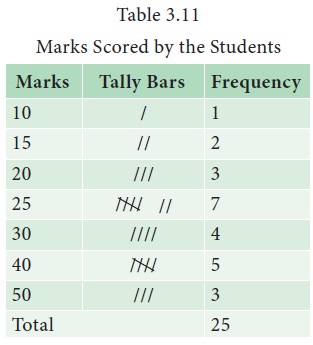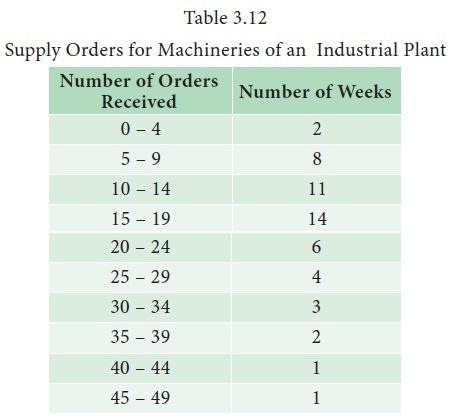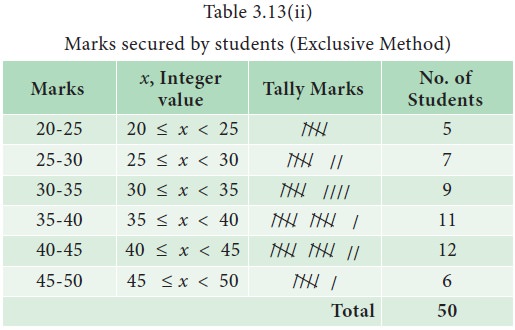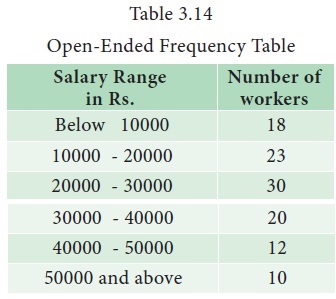Chapter: 11th Statistics : Chapter 3 : Classification and Tabulation of Data
Frequency Distribution
Frequency
Distribution
A
tabular arrangement of raw data by a certain number of classes and the number
of items (called frequency) belonging to each class is termed as a frequency
distribution. The frequency distributions are of two types, namely, discrete
frequency distribution and continuous frequency distribution.
Discrete Frequency Distribution
Raw
data sometimes may contain a limited number of values and each of them appeared
many numbers of times. Such data may be organized in a tabular form termed as a
simple frequency distribution. Thus the tabular arrangement of the data values
along with the frequencies is a simple frequency distribution. A simple
frequency distribution is formed using a tool called ‘tally chart’. A tally chart is constructed
using the following method:
·
Examine
each data value.
·
Record
the occurrence of the value with the slash symbol (/), called tally bar or
tally mark.
·
If
the tally marks are more than four, put a crossbar on the four tally bar and
make this as block of 5 tally bars (////)
·
Find
the frequency of the data value as the total number of tally bars i.e., tally
marks corresponding to that value.
Example 3.11
The
marks obtained by 25 students in a test are given as follows: 10, 20, 20, 30,
40, 25, 25, 30, 40, 20, 25, 25, 50, 15, 25, 30, 40, 50, 40, 50, 30, 25, 25, 15
and 40. The following discrete frequency distribution represents the given
data:


Continuous Frequency Distribution:
It
is necessary to summarize and present large masses of data so that important
facts from the data could be extracted for effective decisions. A large mass of
data that is summarized in such a way that the data values are distributed into
groups, or classes, or categories along with the frequencies is known as a
continuous or grouped frequency distribution.
Example 3.12
Table
3.12 displays the number of orders for supply of machineries received by an
industrial plant each week over a period of one year.

This
table is a grouped frequency distribution in which the number of orders are
given as classes and number of weeks as frequencies. Some terminologies related
to a frequency distribution are given below.
Class: If the observations of a data set
are divided into groups and the groups are
bounded by limits, then each group is called a class.
Class limits: The end values of a class are
called class limits. The smaller value of
the class limits is called lower limit (L) and the larger value is called
the upper limit(U).
Class interval: The difference between the upper
limit and the lower limit is called class
interval (I). That is, I = U – L.
Class boundaries: Class boundaries are the midpoints
between the upper limit of a class
and the lower limit of its succeeding class in the sequence. Therefore, each
class has an upper and lower boundaries.
Width : Width of a particular class is the
difference between the upper class boundary
and lower class boundary.
Mid- point: Half of the difference between the
upper class boundary and lower class
boundary.
In
Example 3.12, the interval 0 - 4 is a class interval with 0 as the lower limit
nd 4 as the upper limit. The upper boundary of this class is obtained as
midpoint of the upper limit of this class and lower limit of its succeeding
class. Thus the upper boundary of the class 0 - 4 is 4.5. The lower class boundary
of this is 0 - 0.5 which is - 0.5. The lower boundary of the class 5 - 9 is
clearly 4.5. Similarly, the other boundaries of different classes can be found.
The width of the classes is 5.
Inclusive and Exclusive Methods of Forming Frequency Distribution
Formation
of frequency distribution is usually done by two different methods, namely
inclusive method and exclusive method.
Inclusive method
In
this method, both the lower and upper class limits are included in the classes.
Inclusive type of classification may be used for a grouped frequency
distribution for discrete variable like members in a family, number of workers
etc., It cannot be used in the case of continuous variable like height, weight
etc., where integral as well as fractional values are permissible. Since both
upper limit and lower limit of classes are included for frequency calculation,
this method is called inclusive method.
Exclusive method
In
this method, the values which are equal to upper limit of a class are not
included in that class and instead they would be included in the next class.
The upper limit is not at all taken into consideration or in other words it is
always excluded from the consideration. Hence this method is called exclusive
method .
Example 3.13
The
marks scored by 50 students in an examination are given as follows:
23,
25, 36, 39, 37, 41, 42, 22, 26, 35, 34, 30, 29, 27, 47, 40, 31, 32, 43, 45, 34,
46, 23, 24, 27, 36, 41, 43, 39, 38, 28, 32, 42, 33, 46, 23, 34, 41, 40, 30, 45,
42, 39, 37, 38, 42, 44, 46, 29, 37.
It
can be observed from this data set that the marks of 50 students vary from 22
to 47. If it is decided to divide this group into 6 smaller groups, we can have
the boundary lines fixed as 25, 30, 35, 40, 45 and 50 marks. Then, we form the
six groups with the boundaries as 21 - 25, 26 - 30, 31 - 35, 36 - 40, 41 – 45
and 46 - 50.
The
continuous frequency distribution formed by inclusive and exclusive methods are
displayed in Table 3.13(i) and Table 3.13(ii), respectively.


True class intervals
In
the case of continuous variables, we take the classes in such a way that there
is no gap between successive classes. The classes are defined in such a way
that the upper limit of each class is equal to lower limit of the succeeding
class. Such classes are known as true classes. The inclusive method of forming
class intervals are also known as not-true classes. We can convert the not-true
classes into true-classes by subtracting 0.5 from the lower limit of the class
and adding 0.5 to the upper limit of each class like 19.5 - 25.5, 25.5 - 30.5,
30.5 – 35.5, 35.5 – 40.5, 40.5 - 45.5, 45.5 – 50.5.
Open End Classes
When
a class limit is missing either at the lower end of the first class interval or
at the upper end of the last classes or when the limits are not specified at
both the ends, the frequency distribution is said to be the frequency
distribution with open end classes.
Example 3.14
Salary
received by 113 workers in a factory are classified into 6 classes. The classes
and their frequencies are displayed in Table 3.14 Since the lower limit of the
first class and the upper limit of the last class are not specified, they are
open end classes.

Guidelines on Compilation of Continuous Frequency Distribution
The
following guidelines may be followed for compiling the continuous frequency
distribution.
·
The
values given in the data set must be contained within one (and only one) class
and overlapping classes must not occur.
·
The
classes must be arranged in the order of their magnitude.
·
Normally
a frequency distribution may have 8 to 10 classes. It is not desirable to have
less than 5 and more than 15 classes.
·
Frequency
distributions having equal class widths throughout are preferable. When this is
not possible, classes with smaller or larger widths can be used. Open ended
classes are acceptable but only in the first and the last classes of the
distribution.
·
It
should be noted that in a frequency distribution, the first class should
contain the lowest value and the last class should contain the highest value.
·
The
number of classes may be determined by using the Sturges formula k = 1 +
3.322log10N, where N is the total frequency and k is the number of classes.
Related Topics